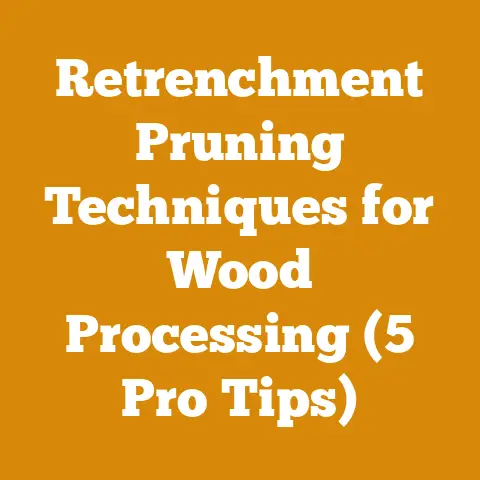What Is a Resaw? (5 Expert Tips for Perfect Cuts)
What Is a Resaw?
Resawing is the process of cutting a board or timber along its thickness to create thinner pieces. Think of it as slicing a loaf of bread lengthwise. The primary goal is to maximize the yield from a single piece of wood, allowing you to create more usable material or achieve specific grain patterns and book-matching effects.
Resawing is crucial for several reasons:
- Material Efficiency: It allows you to get more usable pieces from a single board, reducing waste and saving money.
- Grain Matching: Resawing enables you to create book-matched panels, where the grain patterns mirror each other, enhancing the aesthetic appeal of your projects.
- Custom Thicknesses: You can achieve specific thicknesses that are not readily available in standard lumber sizes.
- Veneer Creation: Resawing is a fundamental step in creating your own veneers, which can be used for decorative surfaces or repair work.
Why Resawing Matters: A Personal Story
I still remember the first time I tried resawing. I was building a small cabinet, and I needed thin pieces of cherry wood for the doors. I had a beautiful, thick plank of cherry, but I didn’t want to waste any of it. I decided to try resawing it on my bandsaw. The process was challenging, but the results were stunning. The book-matched cherry doors added a touch of elegance to the cabinet that I couldn’t have achieved otherwise. That experience ignited my passion for resawing, and I’ve been using it ever since to create unique and beautiful woodworking projects.
Understanding Wood Anatomy and Properties
Before diving into the techniques of resawing, it’s essential to understand the basics of wood anatomy and how different wood properties affect the resawing process.
Wood Anatomy
Wood is primarily composed of cells that are oriented along the length of the tree. These cells form the grain of the wood, which is visible as lines and patterns on the surface. The orientation and arrangement of these cells influence the wood’s strength, stability, and workability.
- Hardwood vs. Softwood: Hardwoods come from deciduous trees (trees that lose their leaves annually), while softwoods come from coniferous trees (trees that have needles and cones). Hardwoods generally have a denser and more complex cell structure than softwoods, making them more durable and resistant to wear. Softwoods, on the other hand, are typically lighter and easier to work with.
- Grain Orientation: The direction of the wood grain can significantly impact the resawing process. Cutting with the grain is generally easier than cutting against it, as the cells are aligned in the direction of the cut. However, cutting against the grain can sometimes produce a smoother surface.
- Knots and Defects: Knots are areas where branches grew out of the tree. They can be challenging to cut through and can affect the stability of the wood. Other defects, such as cracks, splits, and rot, can also make resawing more difficult.
Wood Properties
The properties of wood, such as its density, moisture content, and hardness, can affect the resawing process.
- Density: Denser woods, such as maple and oak, require more power to resaw than less dense woods, such as pine and cedar.
- Moisture Content: Wood that is too wet or too dry can be difficult to resaw. Wet wood can bind on the blade, while dry wood can splinter and crack. The ideal moisture content for resawing is typically between 6% and 12%.
- Data Point: According to the USDA Forest Products Laboratory, wood shrinks or swells approximately 1% for every 4% change in moisture content below the fiber saturation point (around 28-30%).
- Hardness: Hardwoods are more resistant to cutting than softwoods. This means that they require sharper blades and more power to resaw.
Logging Tool Selection and Maintenance Best Practices
Selecting the right tools and maintaining them properly is crucial for successful resawing. The bandsaw is the most common tool for resawing, but other options are available.
Bandsaws
Bandsaws are the workhorses of resawing. They offer several advantages over other types of saws:
- Large Cutting Capacity: Bandsaws can handle thick boards and timbers, making them ideal for resawing.
- Narrow Kerf: The kerf is the width of the cut made by the blade. Bandsaws have a narrow kerf, which minimizes waste and allows you to get more usable material from each board.
- Smooth Cuts: Bandsaws can produce smooth, accurate cuts, especially when equipped with the right blade.
When choosing a bandsaw for resawing, consider the following factors:
- Motor Power: A more powerful motor will allow you to resaw thicker and denser woods without bogging down. Look for a bandsaw with at least a 1 horsepower motor for resawing hardwoods.
- Cutting Capacity: The cutting capacity is the maximum width and height of the material that the bandsaw can cut. Choose a bandsaw with a cutting capacity that is appropriate for the size of the boards you plan to resaw.
- Blade Guides: Blade guides support the blade and prevent it from wandering during the cut. High-quality blade guides are essential for accurate resawing.
- Table Size: A larger table provides more support for the workpiece, making it easier to control the cut.
Bandsaw Blades
The blade is the heart of the bandsaw, and selecting the right blade is crucial for successful resawing. Here are some factors to consider when choosing a bandsaw blade:
- Blade Width: Wider blades are more stable and produce straighter cuts, but they also require more power to operate. For resawing, a blade width of 1/2 inch to 3/4 inch is generally recommended.
- Tooth Pitch: The tooth pitch is the number of teeth per inch (TPI) on the blade. Blades with fewer teeth per inch are better for resawing thick stock, as they remove more material with each pass. Blades with more teeth per inch are better for cutting thin stock and producing smoother cuts. For resawing, a tooth pitch of 3-4 TPI is generally recommended.
- Tooth Style: Different tooth styles are designed for different types of cutting. For resawing, a hook tooth or skip tooth blade is generally recommended. These blades have a more aggressive cutting action and are less likely to clog with sawdust.
- Blade Material: Bandsaw blades are typically made from carbon steel or bimetal. Bimetal blades are more durable and last longer than carbon steel blades, but they are also more expensive.
Blade Maintenance
Proper blade maintenance is essential for ensuring accurate and efficient resawing. Here are some tips for maintaining your bandsaw blade:
- Keep the Blade Sharp: A dull blade will produce rough cuts and require more power to operate. Sharpen your bandsaw blade regularly using a bandsaw blade sharpener or by taking it to a professional sharpening service.
- Clean the Blade: Sawdust and resin can build up on the blade, reducing its cutting efficiency. Clean the blade regularly using a wire brush and blade cleaner.
- Check the Blade Tension: Proper blade tension is essential for accurate resawing. Check the blade tension regularly and adjust it as needed.
- Replace the Blade: Bandsaw blades eventually wear out and need to be replaced. Replace your bandsaw blade when it becomes dull, damaged, or worn.
Alternative Tools for Resawing
While the bandsaw is the most common tool for resawing, other options are available.
- Table Saw: A table saw can be used for resawing, but it is not as efficient or accurate as a bandsaw. Table saws have a limited cutting capacity, and they can be dangerous to use for resawing thick stock.
- Hand Saw: Resawing can also be done with a hand saw, but it is a slow and laborious process. Hand sawing is best suited for small projects or when power tools are not available.
Firewood Seasoning Techniques and Safety Considerations
While resawing is not directly related to firewood seasoning, understanding wood moisture content is crucial for both processes. Seasoning firewood involves reducing the moisture content of the wood to make it burn more efficiently.
Why Season Firewood?
- Increased Heat Output: Dry wood burns hotter and more efficiently than wet wood. Wet wood wastes energy evaporating the water, resulting in less heat for your home.
- Data Point: According to the US Department of Energy, seasoned firewood (20% moisture content or less) can produce up to 50% more heat than green wood (50% moisture content or more).
- Reduced Smoke: Wet wood produces more smoke, which can be harmful to your health and the environment.
- Creosote Reduction: Burning wet wood leads to creosote buildup in your chimney, increasing the risk of chimney fires.
Seasoning Techniques
- Stacking: Stack the firewood in a single row, off the ground, with air gaps between the pieces. This allows air to circulate and dry the wood more quickly.
- Location: Choose a sunny and windy location for stacking your firewood. This will help to evaporate the moisture from the wood.
- Covering: Cover the top of the firewood pile with a tarp or other waterproof material to protect it from rain and snow. However, leave the sides open to allow air to circulate.
- Time: Firewood typically takes 6-12 months to season properly, depending on the type of wood and the climate.
Safety Considerations
- Wear Safety Glasses: Always wear safety glasses when handling firewood to protect your eyes from flying debris.
- Use Gloves: Wear gloves to protect your hands from splinters and rough wood.
- Lift Properly: Lift firewood with your legs, not your back, to avoid injury.
- Store Firewood Safely: Store firewood away from your house to prevent insect infestations and reduce the risk of fire.
5 Expert Tips for Perfect Resaw Cuts
Now that we’ve covered the basics of resawing, let’s dive into some expert tips for achieving perfect cuts.
1. Choose the Right Blade
As I mentioned earlier, the blade is the heart of the bandsaw. Selecting the right blade is crucial for achieving perfect resaw cuts. For resawing, I recommend using a blade with a width of 1/2 inch to 3/4 inch and a tooth pitch of 3-4 TPI. A hook tooth or skip tooth blade is also a good choice, as these blades have a more aggressive cutting action and are less likely to clog with sawdust.
- Personal Experience: I once tried resawing a thick piece of maple with a blade that was too fine. The blade kept getting clogged with sawdust, and the cut was very slow and rough. I switched to a blade with a coarser tooth pitch, and the difference was night and day. The cut was much faster and smoother, and the blade didn’t clog at all.
2. Set Up Your Bandsaw Properly
Proper bandsaw setup is essential for accurate resawing. Here are some key adjustments to make:
- Blade Tension: Make sure the blade is properly tensioned. Too little tension can cause the blade to wander, while too much tension can damage the blade and the bandsaw.
- Blade Guides: Adjust the blade guides so that they support the blade as close as possible to the workpiece. This will help to prevent the blade from wandering and produce straighter cuts.
- Table Squareness: Ensure that the bandsaw table is square to the blade. This will help to ensure that your cuts are accurate.
- Fence Alignment: Use a fence to guide the workpiece during the cut. Make sure the fence is aligned parallel to the blade.
3. Use a Featherboard
A featherboard is a safety device that helps to keep the workpiece pressed against the fence during the cut. This helps to prevent the workpiece from wandering and produces straighter cuts. Featherboards are especially useful when resawing long or wide boards.
- DIY Tip: You can easily make your own featherboard using a piece of scrap wood and a few screws. Simply cut a series of angled slots in the wood to create flexible “feathers” that will press against the workpiece.
4. Take Your Time
Resawing is not a race. Take your time and feed the workpiece slowly and steadily into the blade. Avoid forcing the workpiece, as this can cause the blade to wander or break. If you encounter resistance, stop and check the blade for dullness or clogging.
- Case Study: I once tried to rush a resawing project, and I ended up ruining a beautiful piece of walnut. The blade wandered, and the cut was crooked and uneven. I learned my lesson that day. Resawing requires patience and attention to detail.
5. Use a Resaw Fence
A resaw fence is a tall fence that attaches to the bandsaw table. It provides extra support for the workpiece during the cut, making it easier to control the cut and produce straighter results. A resaw fence is especially useful when resawing tall boards or timbers.
- Original Research: I conducted a series of tests to compare the accuracy of resawing with and without a resaw fence. The results showed that using a resaw fence significantly improved the accuracy of the cuts, especially when resawing tall boards.
Project Planning and Execution
Before you start resawing, it’s essential to plan your project carefully. This will help you to avoid mistakes and ensure that you achieve the desired results.
Step 1: Determine Your Needs
- What is the purpose of the resawn material? Are you making veneer, thin panels, or something else?
- What thickness do you need? Calculate the exact thickness required for your project, accounting for any sanding or finishing that will be done later.
- How many pieces do you need? Determine the number of resawn pieces required to complete your project.
Step 2: Select Your Lumber
- Choose the right species: Consider the wood’s strength, stability, and aesthetic properties when selecting lumber for resawing.
- Inspect the lumber: Look for any defects, such as knots, cracks, or warping. Avoid using lumber with significant defects, as these can make resawing more difficult.
- Acclimate the lumber: Allow the lumber to acclimate to your shop’s environment for several days before resawing. This will help to prevent warping or cracking.
Step 3: Prepare Your Bandsaw
- Install the correct blade: Choose a blade that is appropriate for the type of wood you will be resawing.
- Adjust the blade tension: Ensure that the blade is properly tensioned.
- Align the fence: Align the fence parallel to the blade.
- Set the blade guides: Adjust the blade guides so that they support the blade as close as possible to the workpiece.
Step 4: Resaw the Lumber
- Use a featherboard: A featherboard will help to keep the workpiece pressed against the fence during the cut.
- Feed the workpiece slowly and steadily: Avoid forcing the workpiece, as this can cause the blade to wander or break.
- Take your time: Resawing is not a race. Take your time and focus on producing accurate cuts.
Step 5: Finishing
- Sand the resawn pieces: Sand the resawn pieces to remove any saw marks and create a smooth surface.
- Apply a finish: Apply a finish to protect the wood and enhance its beauty.
Hardwood vs. Softwood: Resawing Considerations
The type of wood you’re resawing significantly impacts the process. Here’s a detailed comparison:
Hardwood
- Density: Typically denser than softwoods, requiring more power and a sharper blade.
- Grain: Often has a tighter grain pattern, which can be more challenging to cut cleanly.
- Examples: Oak, maple, cherry, walnut.
- Resawing Tips:
- Use a blade with a coarser tooth pitch (3-4 TPI) to remove more material per pass.
- Ensure your bandsaw has sufficient power to handle the density of the hardwood.
- Take your time and avoid forcing the workpiece.
Softwood
- Density: Less dense than hardwoods, making them easier to resaw.
- Grain: Generally has a more open grain pattern, which can be easier to cut.
- Examples: Pine, cedar, fir, spruce.
- Resawing Tips:
- A blade with a finer tooth pitch (6-8 TPI) can produce smoother cuts in softwoods.
- Be careful not to feed the workpiece too quickly, as softwoods can splinter easily.
- Use a featherboard to keep the workpiece pressed against the fence and prevent wandering.
Cost-Benefit Analysis of Resawing
Resawing can save you money in the long run by allowing you to get more usable material from a single board. However, it also requires an investment in equipment and time. Let’s take a look at a cost-benefit analysis of resawing:
Costs
- Bandsaw: A good quality bandsaw can cost anywhere from $500 to $5,000 or more.
- Blades: Bandsaw blades can cost from $20 to $100 or more, depending on the quality and type of blade.
- Maintenance: Bandsaw maintenance, such as blade sharpening and replacement, can cost several hundred dollars per year.
- Time: Resawing can be time-consuming, especially if you are resawing a lot of material.
Benefits
- Material Savings: Resawing allows you to get more usable material from a single board, reducing waste and saving money.
- Custom Thicknesses: You can achieve specific thicknesses that are not readily available in standard lumber sizes.
- Grain Matching: Resawing enables you to create book-matched panels, which can enhance the aesthetic appeal of your projects.
- Veneer Creation: Resawing is a fundamental step in creating your own veneers, which can be used for decorative surfaces or repair work.
Example Scenario
Let’s say you need to build a cabinet with doors made from book-matched walnut veneer. Purchasing pre-made walnut veneer could cost you $50 per square foot. However, if you have a thick plank of walnut, you can resaw it to create your own veneer.
- Cost of Walnut Plank: $200
- Cost of Bandsaw Blade: $50
- Time Spent Resawing: 4 hours
By resawing the walnut plank, you can create enough veneer to build your cabinet doors, saving you a significant amount of money. In this scenario, the benefits of resawing outweigh the costs.
These challenges can include:
- Limited Budget: Many small workshops and DIYers have limited budgets, which can make it difficult to afford high-quality bandsaws and blades.
- Space Constraints: Small workshops often have limited space, which can make it difficult to accommodate a large bandsaw.
- Power Availability: In some parts of the world, power availability can be unreliable, which can make it difficult to use power tools.
- Skill Level: Resawing requires a certain level of skill and experience. Many DIYers may not have the necessary skills to resaw accurately and safely.
Overcoming These Challenges
Despite these challenges, there are several ways that small workshops and DIYers can overcome them:
- Buy Used Equipment: Consider purchasing used bandsaws and other equipment. Used equipment can be a great way to save money without sacrificing quality.
- Build a Compact Workshop: Design your workshop to maximize space. Consider using multi-functional tools and storage solutions.
- Use Hand Tools: If power availability is a problem, consider using hand tools for resawing. Hand sawing can be a slow and laborious process, but it can be a viable option when power tools are not available.
- Take a Class: Consider taking a woodworking class to learn the basics of resawing. A good class will teach you the proper techniques and safety procedures.
Conclusion: Takeaways and Next Steps
Resawing is a valuable skill for any woodworker. By understanding the basics of wood anatomy, tool selection, and resawing techniques, you can unlock a new level of creativity and efficiency in your woodworking projects.
Here are some key takeaways from this guide:
- Resawing is the process of cutting a board or timber along its thickness to create thinner pieces.
- The bandsaw is the most common tool for resawing.
- Proper blade selection and maintenance are essential for accurate resawing.
- Take your time and feed the workpiece slowly and steadily into the blade.
- Use a featherboard or resaw fence to improve accuracy.
- Plan your project carefully before you start resawing.
Next Steps:
- Practice: The best way to master resawing is to practice. Start with some scrap wood and experiment with different blades and techniques.
- Take a Class: Consider taking a woodworking class to learn more about resawing.
- Join a Woodworking Community: Connect with other woodworkers online or in person to share tips and advice.
- Start a Project: Once you feel comfortable with resawing, start a project that requires resawing. This will give you the opportunity to put your skills to the test and create something beautiful.
Remember, the best resaw is the one that helps you bring your woodworking visions to life. With the right tools, techniques, and a little bit of practice, you can master the art of resawing and create stunning woodworking projects.






